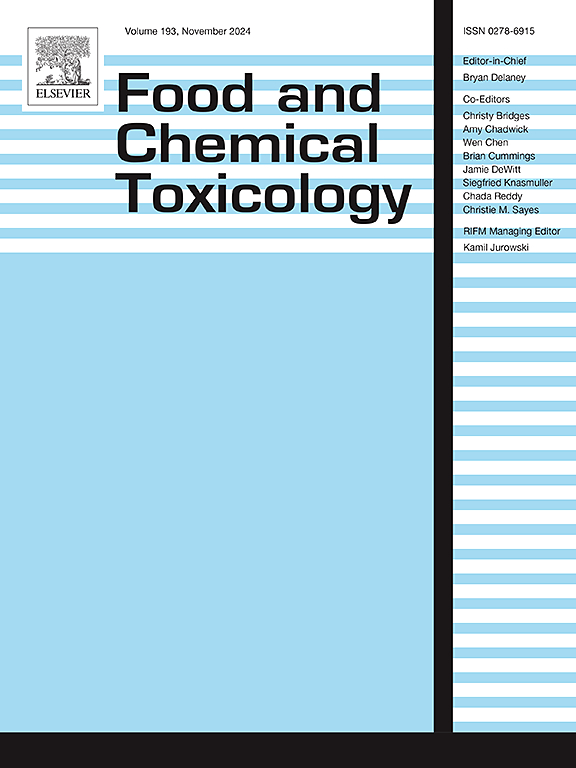Safety of Nutmeg powder by oral exposure: Toxicity prediction and in vivo evaluation
IF 3.9
3区 医学
Q2 FOOD SCIENCE & TECHNOLOGY
引用次数: 0
Abstract
Nutmeg (Myristica fragrans Houtt.) is widely cultivated in tropical regions and valued for its culinary and medicinal uses. However, its safety profile remains underexplored. This study aimed to evaluate the safety of nutmeg powder through in-silico toxicity predictions, acute oral toxicity, and a 13-week repeated-dose toxicity assessment. In the in-silico study, bioactive compounds identified via High-Performance Liquid Chromatography (HPLC) were analyzed for toxicity parameters using the ProTox II server. For acute toxicity, a single dose of nutmeg powder was administered to mice, with no mortality observed over 14 days, and an LD50 greater than 5000 mg/kg body weight was determined. In the sub-chronic toxicity study, rats received nutmeg powder at 1400 mg/kg and 3500 mg/kg (35 and 87.5 times the human therapeutic dosage, respectively) for 90 days. A 28-day recovery phase was included to assess delayed or reversible effects. The results indicate that a dose of 1400 mg/kg leads to liver damage and hemosiderin deposition in the spleen, while a dose of 3500 mg/kg causes liver and kidney damage, as well as hemosiderin deposition in the spleen. These findings highlight the potential toxicity of long-term nutmeg consumption and underscore the need for further research to ensure its safety in preclinical.

肉豆蔻(Myristica fragrans Houtt.)然而,对其安全性的研究仍然不足。本研究旨在通过实验室内毒性预测、急性口服毒性和为期 13 周的重复剂量毒性评估来评价肉豆蔻粉的安全性。在实验室内研究中,使用 ProTox II 服务器分析了通过高效液相色谱法(HPLC)鉴定的生物活性化合物的毒性参数。在急性毒性方面,给小鼠服用单剂量肉豆蔻粉,14 天内未观察到死亡现象,并确定半数致死剂量大于 5000 毫克/千克体重。在亚慢性毒性研究中,大鼠服用肉豆蔻粉的剂量分别为每公斤 1400 毫克和 3500 毫克(分别为人类治疗剂量的 35 倍和 87.5 倍),为期 90 天。研究还包括一个为期 28 天的恢复阶段,以评估延迟或可逆影响。结果表明,1400 毫克/千克的剂量会导致肝脏损伤和脾脏血色素沉积,而 3500 毫克/千克的剂量会导致肝脏和肾脏损伤以及脾脏血色素沉积。这些发现凸显了长期食用肉豆蔻的潜在毒性,并强调有必要开展进一步研究,以确保肉豆蔻在临床前的安全性。
本文章由计算机程序翻译,如有差异,请以英文原文为准。
求助全文
约1分钟内获得全文
求助全文
来源期刊

Food and Chemical Toxicology
工程技术-毒理学
CiteScore
10.90
自引率
4.70%
发文量
651
审稿时长
31 days
期刊介绍:
Food and Chemical Toxicology (FCT), an internationally renowned journal, that publishes original research articles and reviews on toxic effects, in animals and humans, of natural or synthetic chemicals occurring in the human environment with particular emphasis on food, drugs, and chemicals, including agricultural and industrial safety, and consumer product safety. Areas such as safety evaluation of novel foods and ingredients, biotechnologically-derived products, and nanomaterials are included in the scope of the journal. FCT also encourages submission of papers on inter-relationships between nutrition and toxicology and on in vitro techniques, particularly those fostering the 3 Rs.
The principal aim of the journal is to publish high impact, scholarly work and to serve as a multidisciplinary forum for research in toxicology. Papers submitted will be judged on the basis of scientific originality and contribution to the field, quality and subject matter. Studies should address at least one of the following:
-Adverse physiological/biochemical, or pathological changes induced by specific defined substances
-New techniques for assessing potential toxicity, including molecular biology
-Mechanisms underlying toxic phenomena
-Toxicological examinations of specific chemicals or consumer products, both those showing adverse effects and those demonstrating safety, that meet current standards of scientific acceptability.
Authors must clearly and briefly identify what novel toxic effect (s) or toxic mechanism (s) of the chemical are being reported and what their significance is in the abstract. Furthermore, sufficient doses should be included in order to provide information on NOAEL/LOAEL values.
 求助内容:
求助内容: 应助结果提醒方式:
应助结果提醒方式:


